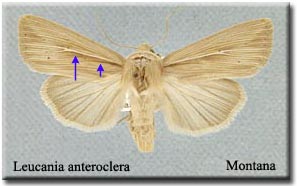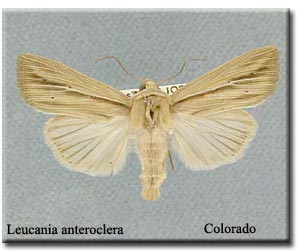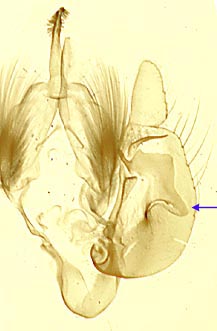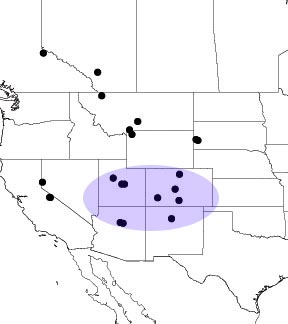



Leucania anteroclara Smith
Diagnosis: Two species are probably confused under this name. The name anteroclera applies to the more northerly of these two entities represented by the upper adult figure on the left. The second entity is probably an undescribed species and is shown in the lower adult figure on the left. No dissections were available for the second "species" and under the rules of the experiment and methodology, no dissections are allowed to clarify the problem. Each "species" is described separately below:
True anteroclera: Adults with two color forms, a light straw-brown form as shown in the figure, and a second form suffused with dull brick-red. A white line runs from the base of the wing to the discal dot represented by a small, black spot. This line accented below with dark brown, but dark shading not running all the way to the discal dot. Other forewing markings vague to absent and, in particular, no dark line arising from near the base of the lower margin of the wing. Hindwing slightly suffused with light brown. This species is found in the northern Rocky Mountains.
Central Rockies "species": Similar to true anteroclera, however the markings are crisper and the wing appearing more striate. In particular the dark accenting under the forewing white line is stronger and reaches all the way from the base to the discal dot. There are a series of dark rectangles following the discal dot. These patches are absent in true anteroclera. A dark line angles outward from the lower margin of the wing. The hindwing is lighter and more translucent than in true anteroclera. This "species" occurs in the central Rocky Mountains of Colorado, Utah, northern Arizona, and New Mexico.
Similar Species: True Leucania anteroclera might be confused with Leucania phragmatidicola. However Leucania phragmatidicola is an eastern species and the ranges of the two species do not appear to overlap. Leucania phragmatidicola is a slightly browner species and the dark accenting of the white line of the forewing is slightly longer extending to, or past, the discal dot. The hindwing of phragmatidicola is almost pure white without the extensive brown suffusion of anteroclera. The process of the male genitalia indicated by the blue arrows is thick and large in anteroclera, but thin and small in phragmatidicola. Leucania multilinea and Leucania lapidaria are very similar to the so-called "Central Rockies species". The dark markings are more pronounced in the "Central Rockies species". In particular there are dark, linear blotches in the forewing just past the discal dot that are weak to absent in multilinea and lapidaria. The ranges of these two eastern species do not seem to approach the range of the "Central Rockies species". The range of Leucania multilinea does overlap that of true Leucania anteroclera in western Alberta, but the dark accenting of the wing and the dark line from the lower margin (inner margin) of multilinea is distinctive.
Distribution (See map below): True Leucania anteroclera is found in southwestern Canada and the northwestern United States from British Columbia in the north and west to South Dakota in the Black Hills region. The so-called "Central Rockies species" occupies Colorado, Utah, northern Arizona and northern New Mexico. The affinities of the Nevada and California specimens are yet to be determined.
Identification Quality: Excellent for the true northern Leucania anteroclera. Very poor for the so-called "Central Rockies species".
Habitat: No specific information available. Both "species" appear to be lower montane in distribution.
Foodplants: None known.
Larval Description: None available,

